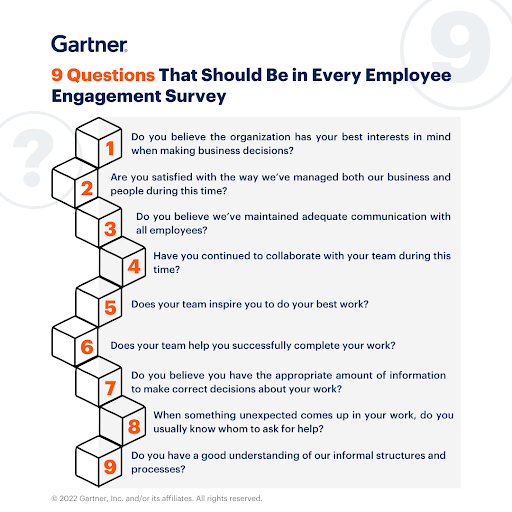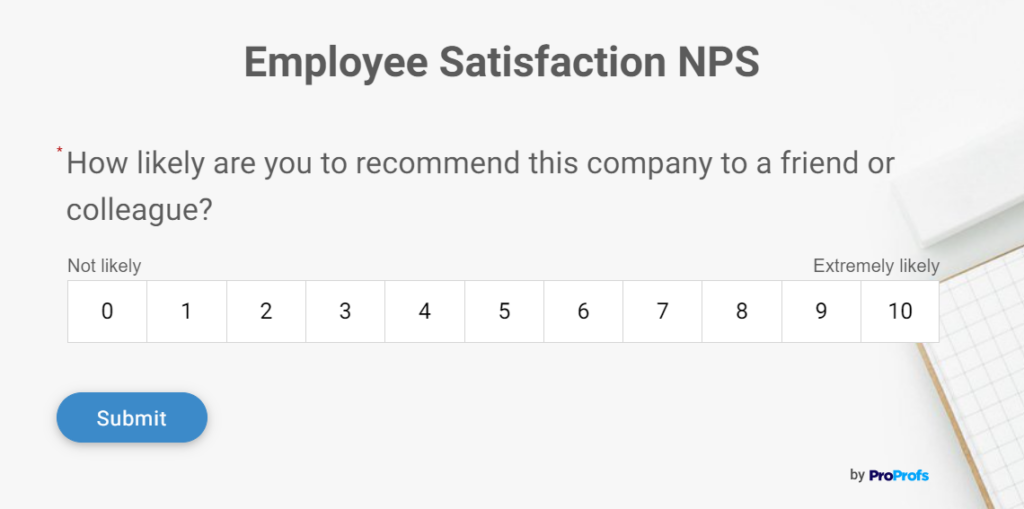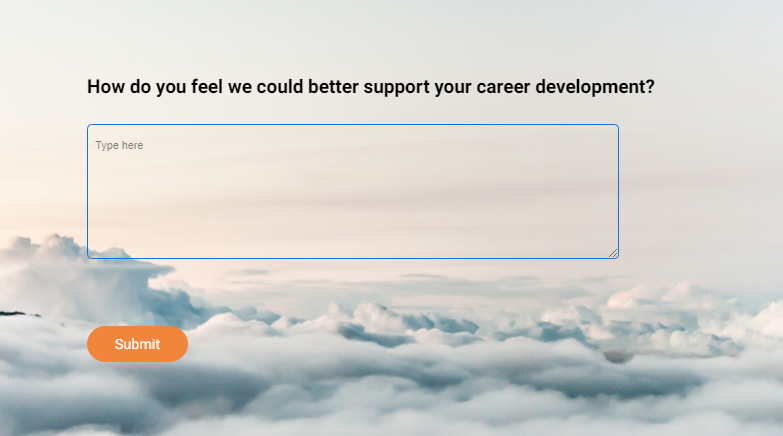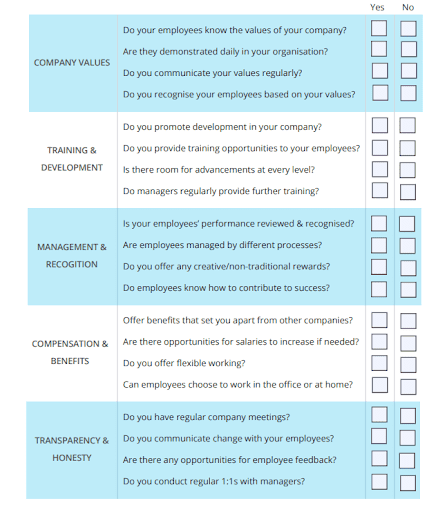
Every other business is facing the “disengagement” pandemic. Whether it is due to a stressful work environment or unsatisfactory pay, employees are showing high levels of disengagement.
So how do you know what your employees feel about their workplace? Are they passionate about their work? Are they facing any hurdles?
Employee engagement surveys can give you the answers.
These surveys provide ample data to let you hear the voices of employees, invest in employee experience, and create a healthy workplace culture.
However, if you are unsure how an employee engagement survey works or what questions to ask, this blog is custom-made for you.
6 Quick Tips to Create Awesome Employee Engagement Surveys
What Are Employee Engagement Surveys?
Employee engagement is a common HR strategy that highlights how dedicated and enthusiastic employees work at the organization.
Employee engagement surveys are tools used to measure this level of commitment and enthusiasm, providing insights into how employees feel about their roles, responsibilities, and the organization as a whole.
Employees who are fully engaged with their workplace are:
- Completely aware of their roles & responsibilities.
- Honest and loyal to the organization and their work.
- More emotionally attached to their work.
- Motivated to contribute to the organization’s success.
There are three major key elements that define engagement:
– SAY: When the employees share positive things about their work and organization.
– STAY: When the employees prefer long-term association with the organization.
– STRIVE: When the employees do something out of the box, putting extra effort into organizational growth.
Use employee surveys to find out whether these three factors are present in your employees and take further steps for improvement, if needed, based on the feedback.
Top 40 Examples of Employee Engagement Survey Questions
It may sound basic, but the most important thing for any employee engagement survey is to include the right set of online questionnaires. Through these questions, you can gauge the engagement level at the workplace, job satisfaction, and employee’s personal and professional goals, among other things.

We will divide employee engagement survey questions into multiple categories. Let’s start.
Employee Satisfaction Questions
A satisfied employee is more productive and enthusiastic. Thus, satisfaction is easy to track, but dissatisfaction is harder to measure. This employee engagement questionnaire will help you understand the way employees think about the workplace.
- What do you feel about work today?
- Do you feel excited about coming to the office every day?
- Do you feel proud of working at this organization?
- Do you feel satisfied with the benefits and compensation this organization is providing you?
- Do you enjoy working with your team and seniors?
- Do you feel your work-life balance is adequately supported by the organization?
- Are you satisfied with the career advancement opportunities available to you?
- Do you feel the organization supports your well-being and mental health?
- How likely are you to recommend this company to a friend or colleague?

Alignment Questions
These questions discuss employees’ alignment within the organization and the overall environment. Asking such questions about employee engagement will help you understand whether the employees feel whatever they are doing matters to the organization.
- Do you think the work you are doing positively impacts the organization?
- Does the organization appreciate you for your efforts and contributions?
- Do you feel your manager supports you in achieving your goals?
- Do you feel the organization provides a supportive work environment?
- Do you feel the organization and upper management invest in your culture initiatives?
- Do you believe the organization values and acts upon your feedback?
- Do you have the resources and tools necessary to perform your job effectively?
- Do you feel the organization has opportunities for professional growth and development?
- Do you feel recognized and rewarded for your achievements and hard work?
- Do you feel that the organization’s leadership communicates effectively with employees?
- Do you feel inspired by the organization’s motto and values?

Future Orientation Questions
These types of employee engagement questions help you understand if the employees want to stay working with you or not in the long term. You can understand the loopholes in the system, if there are any, and track the areas where you need to improve. This way, you can identify frustrated but talented resources.
- Do you think your roles and responsibilities challenge you and help you grow?
- Do you think this organization is the best place for you to advance in your career?
- Do you think you have all the necessary skills and knowledge to boost your growth?
- Have you thought about switching to some other better place recently?
- Has anyone at the company asked about and expressed support for your career growth?
- Do you see yourself growing within this organization over the next few years?
- Are you confident in the organization’s direction and future?
- Do you believe your long-term career goals align with the organization’s objectives?
- Do you feel staying with this organization will benefit your professional development?
- Do you think you will be working at this place for the next 12 months? If not, why?

Qualitative Analysis Questions
Qualitative analysis questions open up the chance to see past numbers and get into the heart of customer sentiments. Through these questions, you will know what your employees truly feel and why. A good way to gather qualitative data is by using open-ended questions, some of which are listed below as examples.
- Do you think this organization needs to change some of its policies? What are those?
- Can you explain a few problems you faced with the organizational culture?
- How can we help improve workplace engagement?
- Is there anything else you feel is important to discuss and must be addressed?
- When was the last time you felt disengaged, and why was it so?
- Share any bad experiences you had working at this organization.
- What would that be if you had to change one thing in upper management?
- What aspects of your job do you find most rewarding, and why?
- Can you describe a time when you felt particularly motivated or demotivated at work?
- How do you feel we could better support your career development?

| Want to create a readymade employee engagement survey? Try ProProfs AI Survey Generator or use our Employee Engagement Survey Template. |
What Should You Consider Before Conducting a Survey?
Every manager or HR department should communicate with employees to understand the reasons for disengagement at the workplace. Without communication, the gap increases, potentially leading to low employee retention rates.
Here, we will discuss the key questions you should ask before the employee engagement survey plan.

Does the survey serve any purpose?
Are you conducting the survey just for the sake of it, or is there a real motive? Every set of employee engagement questions that you include in the survey must have a specific purpose. If the survey has no purpose, it is just a waste of time and resources for both the employer and the employees.
Is it the right time to conduct an employee engagement survey?
An engagement survey can be conducted annually or periodically, depending on the organizational requirements and purpose. Ensure you don’t conduct the survey when employees are working on an important project or deadline.
Are the questions in the survey appropriate?
Ensure that the employee survey questions you ask are healthy and not offensive. Questions should not be biased and maintain decency. Right questions about employee engagement can highlight the pulse of the employees.
Is the survey too lengthy?
Keep survey fatigue in mind while creating a survey. Always remember that the employees have to perform both personal and professional duties. Thus, creating a lengthy survey may result in a low response rate. Create an engaging and short engagement survey so that the employees can answer the questions for employee engagement easily.
Is the survey confidential?
Privacy and confidentiality are major concerns that you must address. Keeping the survey outcomes confidential and anonymous positively impacts the survey response rate. Keep the employees’ details confidential and ensure that they won’t be shared with anyone inside or outside the company.
How to Create An Effective Engagement Survey?
Creating an engagement survey that yields insightful data is challenging. The process involves several key stages, which you should not miss.
We have narrowed down the entire process into 5 simple stages that will help you frame your employee engagement survey.
1. Set Goals & Objectives
Have you thought about what you want to accomplish through this survey?
Every survey has its specific goals. It can be to understand job satisfaction, employee happiness, work ethics, etc. You may want to understand the engagement factors in your organization. Or maybe you want to understand the factors affecting open communication.
Thus, the survey’s firm foundation lies in its firm objectives. Keep in mind that a single survey can solve multiple situations, but that’s highly subjective.
2. Determine Type & Format
Moving on to the next stage, you need to know the type and format of the engagement survey. Now, you need to consider several elements to come to this conclusion. First is the frequency of the survey. These surveys can be annual or pulse surveys, which can be periodic. Next is the depth and length of the survey.
A regular survey should be short and have minimum questions. Annual surveys can have a good number of employee survey questions.
3. Design Your Survey
Both of the above-mentioned stages are crucial for survey design. The survey should be transparent and not look like an online questionnaire on employee engagement randomly picked up. For this, you can hire experts or hire an online survey maker.
You can include a mix of subjective and objective questions, which can help you extract qualitative and quantitative data. Ensure that the employee survey questions aren’t too difficult to answer.
Watch: How to Choose the Best Survey Software
4. Communicate & Share
Communicate clearly and share the survey with the employees. It’s your job to ensure that they understand the value and purpose of an employee engagement survey. As a leader, you must encourage them to participate and share their answers. You can tell how their answers can shape workplace culture.
Also, the survey should have a timeline. You can speak with the project managers/team leads to understand the timing of any ongoing project and can finalize the survey deadline.
5. Analyze the Results
The final stage is the collection and result analysis. Manual analysis is time-consuming and prone to manual errors. You can take the help of an online robust tool that will save time and effort. However, you must ensure that things do not just end here.
Share the results with the employees. Based on the outcome, take suitable actions and change the culture for better employee engagement. Follow up with the employees for further discussions.
FREE. All Features. FOREVER!
Try our Forever FREE account with all premium features!
10 Tips for Creating Employee Engagement Surveys
Employee engagement surveys are a goldmine for understanding your workforce’s pulse. But a poorly designed survey can unearth more frustration than insights. Here’s how to craft a survey that gets real results:
- Write Like You Talk: Ditch jargon and legalese. Use clear, concise language that everyone in your company can understand. Aim for a conversational tone that encourages honest responses.
- Mix it Up: Multiple-choice questions are great but don’t overload your survey. Include open-ended questions to capture employee voices and nuanced experiences.
- Keep it Short & Sweet: Employees are busy. A lengthy survey leads to drop-off and unreliable data. Prioritize the most critical questions and keep them concise. Aim for 10-15 minutes of completion time.
- Anonymity is Key: Guarantee complete anonymity to ensure honest feedback. Consider third-party survey platforms or anonymous submission options.
- Pilot Test, Refine: Before releasing the survey, conduct a pilot test with a small group. This helps identify confusing questions, gauge completion time, and refine the final version.
- Promote Transparency: Communicate the purpose of the survey and how the results will be used. Let employees know their voices matter and will be heard.
- Over-communicate the Timeline: Set clear expectations for when employees can expect to see the results and any subsequent actions taken based on the feedback.
- Don’t Just Collect, Act: Analyze the data, identify trends, and develop a clear action plan. Communicate the plan and progress back to employees, demonstrating that their feedback is valued.
- Make it a Habit: Engagement surveys aren’t a one-time fix. Conduct them regularly to track progress, measure the effectiveness of your actions, and identify new areas for improvement.
Launch Successful Employee Engagement Survey to Improve Workforce Productivity
By now, you should grasp how valuable employee engagement surveys can be for your organization. Though creating these surveys might seem tedious, the benefits—like boosted performance and higher engagement—make it worthwhile.
When designed well, these surveys address multiple issues, giving employees a platform to voice their thoughts and helping identify areas for improvement, fostering a growth-oriented work culture.
To get the best insights, ask clear and relevant questions. New to this? Use an advanced survey tool with templates and analysis features to simplify the process.
The goal is to create a happier, more engaged workforce. By investing time in these surveys and acting on the feedback, you’re building a stronger, more successful organization. Plan carefully, execute thoughtfully, and watch your organization thrive.
To know more, sign up for free or get a demo.
Frequently Asked Questions
1. Why measure employee engagement?
Measuring employee engagement helps understand employee satisfaction, identify areas for improvement, and boost productivity and retention.
2. How to analyze employee engagement survey results?
To analyze employee engagement survey results, aggregate the data, look for trends, segment responses by demographics, and use qualitative analysis for open-ended questions.
3. Why are surveys an effective way to increase employee engagement?
Surveys are effective for increasing employee engagement because they provide a structured way to collect feedback, demonstrate that employee opinions are valued, and help identify actionable improvements.
4. What makes a good engagement survey question?
A good engagement survey question is clear, relevant, unbiased, and designed to elicit honest and detailed responses.
5. How often should you run employee engagement surveys?
You should run comprehensive employee engagement surveys annually, with shorter pulse surveys conducted quarterly or biannually to maintain ongoing insights.
 Tips
Tips
We’d love to hear your tips & suggestions on this article!
FREE. All Features. FOREVER!
Try our Forever FREE account with all premium features!


 We'd love your feedback!
We'd love your feedback! Thanks for your feedback!
Thanks for your feedback!







